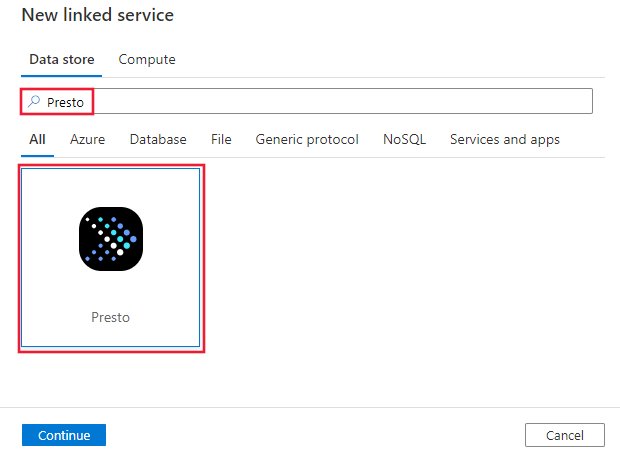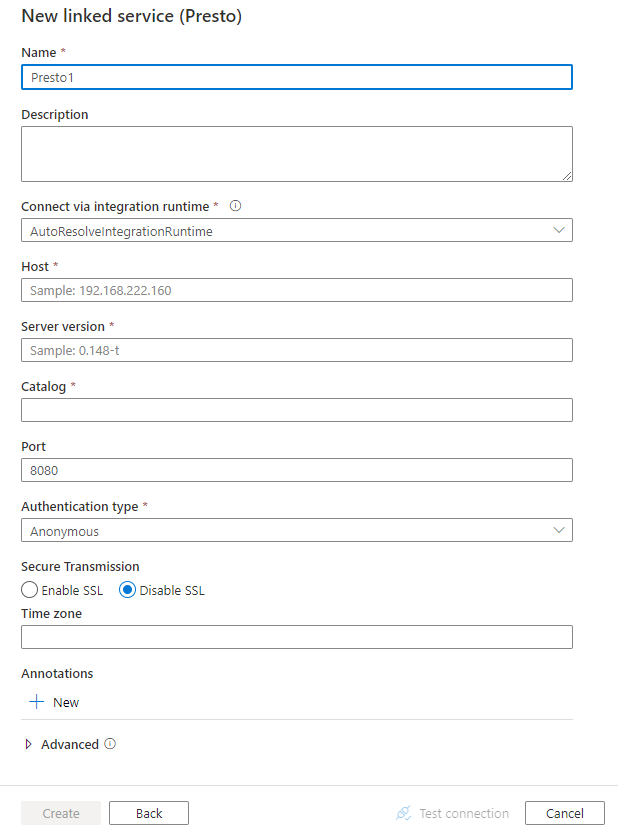Note
Access to this page requires authorization. You can try signing in or changing directories.
Access to this page requires authorization. You can try changing directories.
APPLIES TO:  Azure Data Factory
Azure Data Factory  Azure Synapse Analytics
Azure Synapse Analytics
This article outlines how to use the Copy Activity in an Azure Data Factory or Synapse Analytics pipeline to copy data from Presto. It builds on the copy activity overview article that presents a general overview of copy activity.
Supported capabilities
This Presto connector is supported for the following capabilities:
| Supported capabilities | IR |
|---|---|
| Copy activity (source/-) | ① ② |
| Lookup activity | ① ② |
① Azure integration runtime ② Self-hosted integration runtime
For a list of data stores that are supported as sources/sinks by the copy activity, see the Supported data stores table.
The service provides a built-in driver to enable connectivity, therefore you don't need to manually install any driver using this connector.
Getting started
To perform the Copy activity with a pipeline, you can use one of the following tools or SDKs:
- The Copy Data tool
- The Azure portal
- The .NET SDK
- The Python SDK
- Azure PowerShell
- The REST API
- The Azure Resource Manager template
Create a linked service to Presto using UI
Use the following steps to create a linked service to Presto in the Azure portal UI.
Browse to the Manage tab in your Azure Data Factory or Synapse workspace and select Linked Services, then click New:
Search for Presto and select the Presto connector.

Configure the service details, test the connection, and create the new linked service.

Connector configuration details
The following sections provide details about properties that are used to define Data Factory entities specific to Presto connector.
Linked service properties
The Presto connector now supports version 2.0 (Preview). Refer to this section to upgrade your Presto connector version from version 1.0. For the property details, see the corresponding sections.
Version 2.0 (Preview)
The Presto linked service supports the following properties when apply version 2.0 (Preview):
| Property | Description | Required |
|---|---|---|
| type | The type property must be set to: Presto | Yes |
| version | The version that you specify. The value is 2.0. |
Yes |
| host | The IP address or host name of the Presto server. (e.g. 192.168.222.160) | Yes |
| catalog | The catalog context for all request against the server. | Yes |
| port | The TCP port that the Presto server uses to listen for client connections. The default value is 8443. | No |
| authenticationType | The authentication mechanism used to connect to the Presto server. Allowed values are: Anonymous, LDAP |
Yes |
| username | The user name used to connect to the Presto server. | No |
| password | The password corresponding to the user name. Mark this field as a SecureString to store it securely, or reference a secret stored in Azure Key Vault. | No |
| enableSsl | Specifies whether the connections to the server are encrypted using TLS. The default value is true. | No |
| enableServerCertificateValidation | Specify whether to enable server SSL certificate validation when you connect. Always use System Trust Store. The default value is true. |
No |
| timeZoneID | The local time zone used by the connection. Valid values for this option are specified in the IANA Time Zone Database. The default value is the Presto system time zone. | No |
Example:
{
"name": "PrestoLinkedService",
"properties": {
"type": "Presto",
"version" : "2.0",
"typeProperties": {
"host" : "<host>",
"catalog" : "<catalog>",
"port" : 8443,
"authenticationType" : "LDAP",
"username" : "<username>",
"password": {
"type": "SecureString",
"value": "<password>"
},
"enableSsl": true,
"enableServerCertificateValidation": true,
"timeZoneID" : ""
}
}
}
Version 1.0
The Presto linked service supports the following properties when apply version 1.0:
| Property | Description | Required |
|---|---|---|
| type | The type property must be set to: Presto | Yes |
| host | The IP address or host name of the Presto server. (e.g. 192.168.222.160) | Yes |
| serverVersion | The version of the Presto server. (e.g. 0.148-t) | Yes |
| catalog | The catalog context for all request against the server. | Yes |
| port | The TCP port that the Presto server uses to listen for client connections. The default value is 8080. | No |
| authenticationType | The authentication mechanism used to connect to the Presto server. Allowed values are: Anonymous, LDAP |
Yes |
| username | The user name used to connect to the Presto server. | No |
| password | The password corresponding to the user name. Mark this field as a SecureString to store it securely, or reference a secret stored in Azure Key Vault. | No |
| enableSsl | Specifies whether the connections to the server are encrypted using TLS. The default value is false. | No |
| trustedCertPath | The full path of the .pem file containing trusted CA certificates for verifying the server when connecting over TLS. This property can only be set when using TLS on self-hosted IR. The default value is the cacerts.pem file installed with the IR. | No |
| useSystemTrustStore | Specifies whether to use a CA certificate from the system trust store or from a specified PEM file. The default value is false. | No |
| allowHostNameCNMismatch | Specifies whether to require a CA-issued TLS/SSL certificate name to match the host name of the server when connecting over TLS. The default value is false. | No |
| allowSelfSignedServerCert | Specifies whether to allow self-signed certificates from the server. The default value is false. | No |
| timeZoneID | The local time zone used by the connection. Valid values for this option are specified in the IANA Time Zone Database. The default value is the Azure Data Factory time zone. | No |
Example:
{
"name": "PrestoLinkedService",
"properties": {
"type": "Presto",
"typeProperties": {
"host" : "<host>",
"serverVersion" : "0.148-t",
"catalog" : "<catalog>",
"port" : "<port>",
"authenticationType" : "LDAP",
"username" : "<username>",
"password": {
"type": "SecureString",
"value": "<password>"
},
"timeZoneID" : "Europe/Berlin"
}
}
}
Dataset properties
For a full list of sections and properties available for defining datasets, see the datasets article. This section provides a list of properties supported by Presto dataset.
To copy data from Presto, set the type property of the dataset to PrestoObject. The following properties are supported:
| Property | Description | Required |
|---|---|---|
| type | The type property of the dataset must be set to: PrestoObject | Yes |
| schema | Name of the schema. | No (if "query" in activity source is specified) |
| table | Name of the table. | No (if "query" in activity source is specified) |
| tableName | Name of the table with schema. This property is supported for backward compatibility. Use schema and table for new workload. |
No (if "query" in activity source is specified) |
Example
{
"name": "PrestoDataset",
"properties": {
"type": "PrestoObject",
"typeProperties": {},
"schema": [],
"linkedServiceName": {
"referenceName": "<Presto linked service name>",
"type": "LinkedServiceReference"
}
}
}
Copy activity properties
For a full list of sections and properties available for defining activities, see the Pipelines article. This section provides a list of properties supported by Presto source.
Presto as source
To copy data from Presto, set the source type in the copy activity to PrestoSource. The following properties are supported in the copy activity source section:
| Property | Description | Required |
|---|---|---|
| type | The type property of the copy activity source must be set to: PrestoSource | Yes |
| query | Use the custom SQL query to read data. For example: "SELECT * FROM MyTable". |
No (if "tableName" in dataset is specified) |
Example:
"activities":[
{
"name": "CopyFromPresto",
"type": "Copy",
"inputs": [
{
"referenceName": "<Presto input dataset name>",
"type": "DatasetReference"
}
],
"outputs": [
{
"referenceName": "<output dataset name>",
"type": "DatasetReference"
}
],
"typeProperties": {
"source": {
"type": "PrestoSource",
"query": "SELECT * FROM MyTable"
},
"sink": {
"type": "<sink type>"
}
}
}
]
Data type mapping for Presto
When you copy data from Presto, the following mappings apply from Presto's data types to the internal data types used by the service. To learn about how the copy activity maps the source schema and data type to the sink, see Schema and data type mappings.
| Presto data type | Interim service data type (for version 2.0 (Preview)) | Interim service data type (for version 1.0) |
|---|---|---|
| ARRAY | String | String |
| BIGINT | Int64 | Int64 |
| BOOLEAN | Boolean | Boolean |
| CHAR | String | String |
| DATE | Date | Datetime |
| DECIMAL (Precision < 28) | Decimal | Decimal |
| DECIMAL (Precision >= 28) | Decimal | String |
| DOUBLE | Double | Decimal |
| INTEGER | Int32 | Int32 |
| INTERVAL_DAY_TO_SECOND | TimeSpan | Not supported. |
| INTERVAL_YEAR_TO_MONTH | String | Not supported. |
| IPADDRESS | String | Not supported. |
| JSON | String | String |
| MAP | String | String |
| REAL | Single | Single |
| ROW | String | String |
| SMALLINT | Int16 | Int16 |
| TIME | Time | TimeSpan |
| TIME_WITH_TIME_ZONE | String | String |
| TIMESTAMP | Datetime | Datetime |
| TIMESTAMPWITHTIMEZONE | Datetimeoffset | Not supported. |
| TINYINT | SByte | Int16 |
| UUID | Guid | Not supported. |
| VARBINARY | Byte[] | Byte[] |
| VARCHAR | String | String |
Lookup activity properties
To learn details about the properties, check Lookup activity.
Upgrade the Presto connector
Here are steps that help you upgrade the Presto connector:
In Edit linked service page, select version 2.0 (Preview) and configure the linked service by referring to linked service version 2.0 (Preview) properties.
The data type mapping for the Presto linked service version 2.0 (Preview) is different from that for the version 1.0. To learn the latest data type mapping, see Data type mapping for Presto.
Differences between Presto connector version 2.0 (Preview) and version 1.0
The Presto connector version 2.0 (Preview) offers new functionalities and is compatible with most features of version 1.0. The following table shows the feature differences between version 2.0 (Preview) and version 1.0.
| Version 2.0 (Preview) | Version 1.0 |
|---|---|
serverVersion is not supported. |
serverVersion is supported. |
The default value of port is 8443. |
The default value of port is 8080. |
The default value of enableSSL is true.enableServerCertificateValidation is supported. trustedCertPath, useSystemTrustStore, allowHostNameCNMismatch and allowSelfSignedServerCert are not supported. |
The default value of enableSSL is false.enableServerCertificateValidation is not supported. trustedCertPath, useSystemTrustStore, allowHostNameCNMismatch and allowSelfSignedServerCert is supported. |
The default value of timeZoneID is the Presto system time zone. |
The default value of timeZoneID is the Azure Data Factory time zone. |
| The following mappings are used from Presto data types to interim service data type. DATE -> Date DECIMAL (Precision >= 28) -> Decimal DOUBLE -> Double INTERVAL_DAY_TO_SECOND -> TimeSpan INTERVAL_YEAR_TO_MONTH -> String IPADDRESS -> String TIME -> Time TIMESTAMPWITHTIMEZONE -> Datetimeoffset TINYINT -> SByte UUID -> Guid |
The following mappings are used from Presto data types to interim service data type. DATE -> Datetime DECIMAL (Precision >= 28) -> String DOUBLE -> Decimal TIME -> TimeSpan TINYINT -> Int16 Other mappings supported by version 2.0 (Preview) listed left are not supported by version 1.0. |
Related content
For a list of data stores supported as sources and sinks by the copy activity, see supported data stores.

